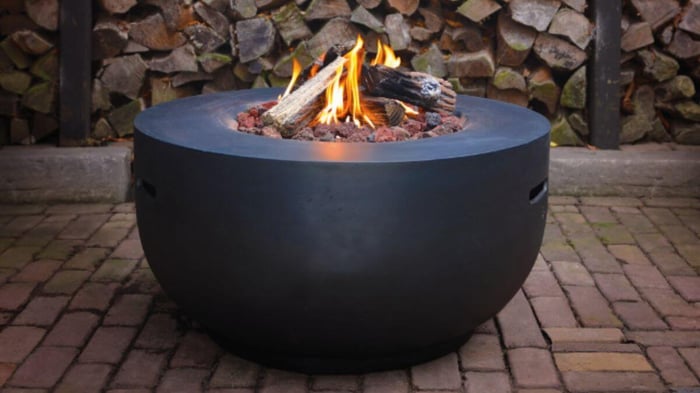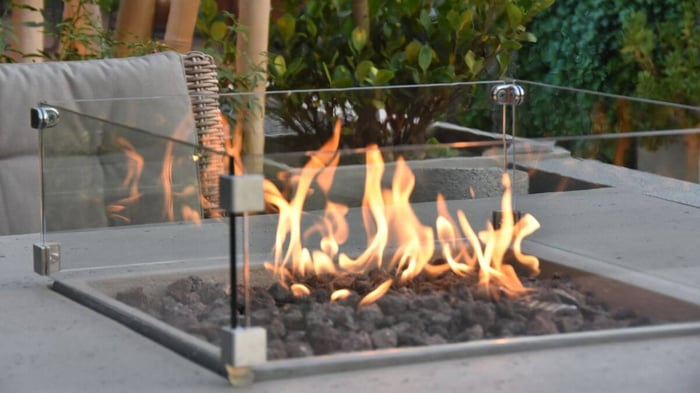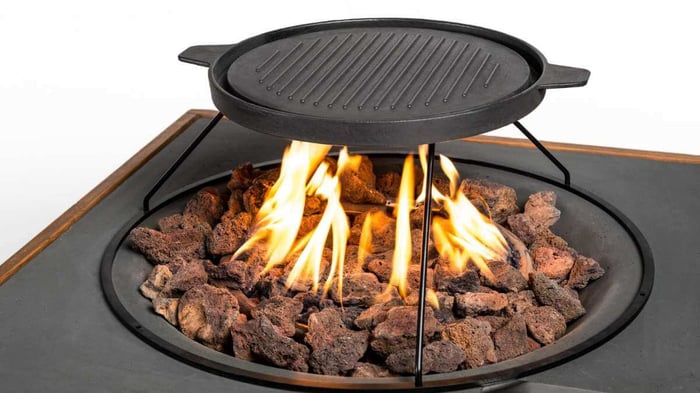If you’ve decided to go for a gas fire pit with lava rocks, we commend you on your decision – you get an even heat distribution and a richer flame, which sets the ambience for your outdoor gathering.
How To Arrange Lava Rocks On A Gas Fire Pit
But did you know there’s a right and wrong way to distribute lava rocks on your gas fire pit?
But don’t worry – this article will cover everything you need to know to get the perfect heat and flame for your gas pit, paying particular attention to how best to arrange your lava rocks and ending with a handy FAQ section.
Let’s get straight to it!
Why Use Lava Rocks On A Gas Fire Pit?
First and foremost, it's crucial to understand the purpose of lava rocks in a gas fireplace. The primary reason is that you should not operate a fire pit without a protective substrate layer on the bottom.
There are several options for this protective substrate layer.
Some people opt for materials such as fire pit glass, bricks, or paving stones. However, one of the most common and beneficial materials is lava rocks.
We would argue that lava rocks are an excellent option for several reasons. Notably, lava rocks have a very porous texture, which implies that:
-
They contain no moisture
-
They don’t hold any heat in, allowing the flames to heat you
-
They allow more airflow to your burner
-
They distribute the heat more evenly
-
They give you a richer flame, and
-
They are low maintenance and last for a minimum of 3 years
-
Lava rocks also happen to be more affordable than fire glass.
Why You Have To Be Careful About How You Arrange Lava Rocks On A Gas Fire Pit
You must use at least enough lava rock to cover the fire ring in a propane-fueled fire pit because propane is heavier than air, so it must be dispersed close to the flame.
You have to be careful about arranging lava rocks on your gas fire pit because not doing so could cause the burner to warp due to excessive heat.
This could even burn holes into the burner if the hot spot is too close. And, of course, this will make the burner unfit for its purpose.
Important Notes – Only Use Bone Dry Lava Rocks.
How To Arrange Lava Rocks On A Gas Fire Pit
The lava rocks you place in the fire pit must be bone dry; otherwise, if there’s any moisture there, this can cause the lava rock to explode, and you’ll have hot rocks flying out of the fire pit.
Furthermore, don’t be tempted to use regular rock or gravel instead of lava rock because it has a greater potential to explode when heated.
That said, it’s perfectly OK to use a combination of lava rocks and fire glass in your gas fire pit if you wish. It will enhance the appearance of the fire pit and the flame.
You should also dust off the lava rocks before applying them to the fire pit. The rocks will have accumulated dust from how they were sourced, which could block the jet of the gas fire and prevent the flames from coming through, reducing the fire pit’s performance.
How Best To Arrange The Lava Rocks On Your Gas Fire Pit
First, as a protective layer, we recommend using small lava rocks at the bottom of the fire pit, ideally between a quarter and a half inch in size. This is essential.
Once this is done, you must continue adding more lava rocks until you have a layer of lava rocks at least 4 to 5 inches deep.
Why This Is The Best Way To Arrange The Lava Rocks On Your Gas Fire Pit?
The initial layer of lava rocks has to allow enough heat and flames to come through, but without them being so small, they will block the jet. This also serves to shield the burner from exposure.
The purpose of the 4 to 5-inch high distribution of lava rocks is to shield the burner from outdoor weather conditions.
Should the Lava Rocks Cover the Burner
They shouldn't directly cover the burner. Instead, they should rest on a grate positioned above it. This arrangement allows the gas to flow freely, ensuring an even flame and consistent heat.
The rocks themselves absorb and radiate this heat, creating a warm, ambient environment.
Wrap Up
By this point, you should feel assured that using lava rocks for your gas fire pit is a great choice if you take all the safety precautions in this article.
Then you should be equally assured that you now know how best to arrange lava rocks on your gas fire pit to the best effect while at the same time ensuring that the fire pit is as safe as it can be.
Can You Use Lava Rocks in a Wood-Burning Fire Pit?
Yes, you can use lava rocks in wood-burning fire pits.
They effectively retain and distribute heat, enhancing the overall warmth around the fire pit.
Additionally, their porous nature offers a protective barrier for the pit's base, aiding heat distribution and preventing water accumulation.
Frequently Asked Questions
Is Lava Rock Or Glass Better For A Propane Fire Pit?
While lava rocks are certainly the most affordable option and offer a nice, rustic aesthetic, many people prefer to use fire glass if they have the budget to do so since this adds an element of sparkle, colour, and sophistication to the fire.
Where Do The Lava Rocks Go In A Gas Fireplace?
Putting lava rocks in a gas fireplace differs from putting them in a gas fire pit. The rocks should be poured on the base of the fireplace and around the burner pan.
Do You Need To Wash Lava Rocks Before Using Them?
You can wash lava rocks before you use them if this is how you wish to remove the dust from them. However, you must ensure the lava rocks are 100% bone dry before you put them on the fire pit because moisture can cause them to explode.
Subscribe to our email
Just enter your email address below to receive a monthly email with links to all the latest blog posts. Simple unsubscribe at any time.






